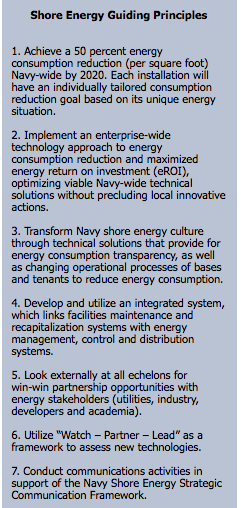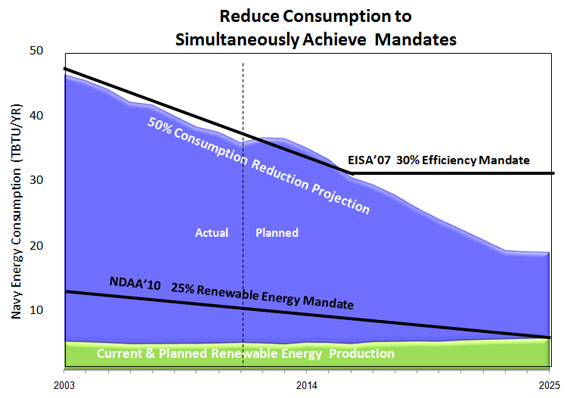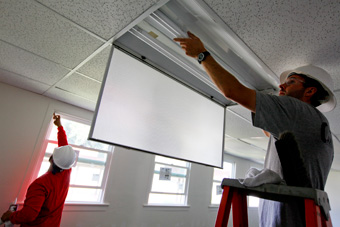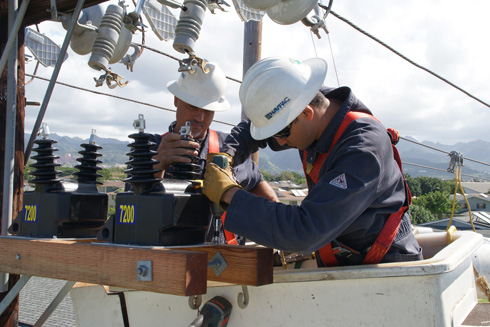U.S. Navy: Shore Energy Reform
The U.S. Navy, like the rest of the military, used to think about energy as a commodity. Now we think of it as a National Security requirement. It is a strategic resource and is fundamental to our mission. Tragedies like Sept. 11 remind us that we are not untouchable on our homeland. We have to accept that many aspects of our internal infrastructure are vulnerable to both external threats and internal failures. When more than 55 million people in Canada and the United States (including New York City) lost power during the 2003 Northeast blackout, we experienced a stark reminder of our dependency on electricity for mass transportation, communication and even our water supply.
Navy leadership across the Department firmly believes energy reform is a strategic imperative. Our access to traditional energy sources like oil and gas is not guaranteed, and we know supply will not always meet demand. And, in this era of tightening budgets, we simply cannot afford bloated utility bills. At the first annual Naval Energy Forum in 2009, Secretary of the Navy Ray Mabus committed us to bold and ambitious energy goals. On the shore side, 50 percent of our energy use must come from alternative sources by 2020. Although the Navy already had a myriad of legal mandates and Executive Orders to increase energy efficiency and use of alternative energy, Mabus’ targets challenged us to push even further to become world leaders in energy reform.
 To meet this challenge, the Chief of Naval Operations’ Shore Readiness Division, along with the Navy Installations Command and Naval Facilities Engineering Command (NAVFAC), launched a re-invigorated Navy Shore Energy approach in July 2010. This program is centered on achieving legal compliance and assuring energy security for critical assets ashore through a three-pronged strategy of pursuing energy efficiency first, transforming our culture and behavior, and integrating viable renewable energy and sustainability.
To meet this challenge, the Chief of Naval Operations’ Shore Readiness Division, along with the Navy Installations Command and Naval Facilities Engineering Command (NAVFAC), launched a re-invigorated Navy Shore Energy approach in July 2010. This program is centered on achieving legal compliance and assuring energy security for critical assets ashore through a three-pronged strategy of pursuing energy efficiency first, transforming our culture and behavior, and integrating viable renewable energy and sustainability.
Energy Security
Energy security is about protecting critical assets ashore. We may experience natural disasters, major accidents, physical attacks and cyber attacks, but our Naval forces afloat require constant support from shore installations. Losing certain capabilities, even for a short time, could seriously hinder operations. This is not an acceptable risk in today’s world.
Today when we power critical shore assets, we must think not only about how much energy we need, but how we get it. We have to make sure our energy source is resilient, redundant and reliable. If not, we could ultimately endanger the lives of our warfighters who depend on these systems to complete vital missions.
Energy Efficiency
The Navy is focusing first on improving infrastructure energy efficiency. This strategy is the most cost-effective way to achieve our multiple goals. The Navy requires all new construction and major renovation projects to meet national sustainable building standards by demonstrating energy savings, water efficiency, carbon emissions reduction and other benefits. To upgrade its current infrastructure, the Navy will invest unprecedented levels of funding within the next five years in energy technology and capital improvements at the installation level using the Energy Return on Investment (eROI) tool administered by Navy Installations Command. By dramatically reducing energy consumption, we not only lower our energy bills and meet legal mandates, but we also make our aggressive alternative energy goals attainable.

Courtesy US Navy|A reduction in energy intensity ashore reduces the requirement for alternatives.
Energy Culture
The Navy will change its energy culture by linking consumption to behavior through awareness and accountability at the individual, command and functional levels. To assist in transformation, we are investing in enabling technologies like Advanced Metering Infrastructure and developing an installation “Smart Grid” to provide leaders greater visibility and control of energy distribution. By 2013 energy consumption will be tracked at building level, and commanding officers ashore will be held accountable for energy consumption. Everybody – from junior Sailor to senior executive – has a role in this culture change. We are not going to get there overnight, but I am confident the Navy can truly transform its culture into one that takes energy consumption into consideration with every decision.
Renewable Energy and Sustainability
The Navy simply cannot afford to “go green at any cost.” While technologies are more effective and efficient than ever, progress must be achieved to make widespread use of these technologies possible. Most renewable and alternative energy technology sources do not have a favorable return on investment (both financial and non-financial) for every Navy installation.

U.S. Navy photo by Greg Vojtko
So the Navy is using a “Watch –Partner – Lead” approach to integrate viable technology in the right place at the right time. We will “watch” maturing technologies that industry is developing and invest when and where viable. We will “partner” with other government organizations and/or private sector to develop needed technologies. Finally, we will “lead” development of technologies that are mission-critical to the Navy. Our work in ocean energy for island bases is one example of our leading energy technology development.
Strategy for Success
The Navy and the Nation face real challenges in energy reform. Our Nation’s electric grid does not inherently enable pervasive use of renewable energy technology. Unlike traditional energy generation technology, most renewable and alternative energy sources (like wind turbines and solar panels) generate variable energy and often cannot be built on a large scale near energy consumers. To make new technologies viable, progress must be made in the areas of energy storage and distribution. In the same sense, changes must occur at the local and state levels to encourage widespread use of renewable and alternative energy. The Navy must work closely with our partners in the private and public sectors, as well as local officials, to meet our goals. We will be looking outward from our bases to seek win-win energy partnering opportunities to meet our enterprise goals while allowing for local differences at bases across the country and the world.
As a vital component of the Navy’s Energy Strategy, the Navy Shore Energy Approach is focused on making near-term investments to reach long-term strategic goals. I feel truly fortunate to be part of such an exciting transformation in shore readiness and look forward to guiding the Navy’s progress in energy reform.

U.S. Navy photo by Denise Emsley





























